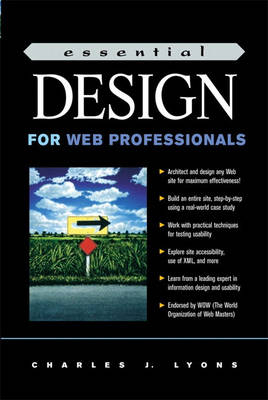
Essential Design for Web Professionals
Prentice Hall (Verlag)
978-0-13-032161-9 (ISBN)
- Titel ist leider vergriffen;
keine Neuauflage - Artikel merken
Don't just build Web sites: architect them for maximum usability and effectiveness! In this book, leading usability and information design specialist Charles J. Lyons shows you how. Discover easy, practical ways to identify your users' requirements, translate their needs into superb content and navigation -- and avoid user confusion and expensive site retrofitting. Using a hands-on case study and live companion Web site, Essential Design for Web Professionals walks you through every step of the process: analysis, site design, delivery, and beyond! Usability expert Charles J. Lyons demonstrates how to identify your users' key needs and requirements; then build sites that can evolve and grow to meet them more and more effectively. You'll learn how to define logical, clear, easy-to-use navigation systems; use graphics more effectively; and test your site's usability with real users. Lyons shows how to globalize your Web presence for worldwide audiences; make your site accessible to the physically challenged -- and even leverage the awesome power of XML.
CHARLES J. LYONS is President and Founder of Tektrain, Inc., a leading provider of technical training. He was previously a Member of Technical Staff at Lucent Technologies' Learning & Performance Center, responsible for the development and delivering of training in human factors and usability, Web development and HTML, rapid prototyping, and effective technical documentation development. Lyons was also responsible for developing and maintaining the Center's internal Human Factors Curriculum Web site.
Introduction.
Acknowledgments.
About the Author.
1. Introduction to Web Analysis and Design.
Web Design Difficulties. Summary: Web Design Difficulties. Transition to Analysis. The Web Development Cycle. Differences in GUI and Web Design. The Prototyping Cycle. Source of System Errors.
2. Analysis.
Analysis Steps. Shelley Biotechnologies. Determining the Goals of Your Site. Determining the Success Criteria for Your Website. Determining the Audience and How They Will Use the Website. Information Topics. Information Taxonomy. Task Analysis. Website Constraints. Modifying Website to Reflect Constraints. Transition to Design.
3. Design.
Design Steps. Conceptual Model. General Design Principles. Navigation Questions. Fundamental Principles of Web Design. Fundamental Principles Applied to Architecture and Navigation. Subphases of Design. Navigation Design. Information Structure. Content Design. Fundamental Principles Applied to Content. Prototyping.
4. Implementation and Testing.
Introduction. Before You Begin. Dreamweaver as an Implementation Tool. Using Dreamweaver to Implement the Shelley Biotechnologies Site. Task Overview. Creating the Remaining Files for Shelley Biotechnologies.Where We Are. Completing the Welcome to Shelley Biotechnologies! Home Page. Completing the Products Web Page. Completing the How to Order Form. Next Step: Completing Development of Your Training Pages. Shelley Biotechnolgies Wrap-up.
5. General Guidelines.
Audience. Navigation. Content. Web Pages. Quality. Security.
6.Graphics.
Introduction. File Formats. Color. An Experiment. Image Maps. Graphics Tools.
7. Accessible Design for Users with Disabilities.
Introduction. Americans with Disabilities Act. Categories of Disabilities.
8. Advanced Web Design Using Extensible Markup Language (XML).
Introduction to XML. Comparing HTML AND XML. XML Design Goals. Virtual Writing, Media Notwithstanding™. XML Parsers. Legacy Information. Where is XML Going?. XML and XHTML Specifications.
Appendix A. Recommended Reading.
Appendix B. XML Specification.
Extensible Markup Language (XML) 1.0. Abstract. Status of this document. Table of Contents. 1. Introduction. 2. Documents. 3. Logical Structures. 4. Physical Structures. 5. Conformance. 6. Notation.
Appendices.
A. References. B. Character Classes. C. XML and SGML (Non-Normative). D. Expansion of Entity and Character References (Non-Normative). E. Deterministic Content Models. Non-Normative). F. Autodetection of Character Encodings. (Non-Normative).G. W3C XML Working Group (Non-Normative).
Appendix C. XHTML Specification.
XHTML 1.0: The Extensible HyperText Markup Language. A Reformulation of HTML 4 in XML 1.0. W3C Recommendation 26 January 2000. Abstract. Status of this document. Contents. 1. What is XHTML? 2. Definitions. 3. Normative Definition of XHTML 1.0. 4. Differences with HTML 4. 5. Compatibility Issues. 6. Future Directions. Appendix A. DTDs. Appendix B. Element Prohibitions. Appendix C. HTML Compatibility Guidelines. Appendix D. Acknowledgments. Appendix E. References.
Appendix D. Document Notice: W3C.
Document Notice.
Glossary.
Index.
| Erscheint lt. Verlag | 18.4.2001 |
|---|---|
| Verlagsort | Upper Saddle River |
| Sprache | englisch |
| Maße | 151 x 229 mm |
| Gewicht | 431 g |
| Themenwelt | Mathematik / Informatik ► Informatik ► Grafik / Design |
| Mathematik / Informatik ► Informatik ► Web / Internet | |
| ISBN-10 | 0-13-032161-3 / 0130321613 |
| ISBN-13 | 978-0-13-032161-9 / 9780130321619 |
| Zustand | Neuware |
| Haben Sie eine Frage zum Produkt? |
aus dem Bereich


